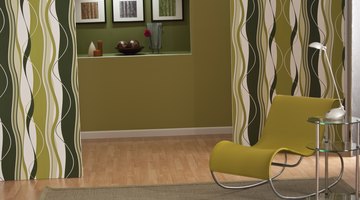Homemade Panel Track Blinds
Panel track blinds are full length sheets of fabric that collect to one side when open and overlap a few inches when closed. This window treatment style has emerged as an update to narrow vertical blinds. The tracks are less fussy and the fabric covering looks more modern.

The best hanging and appearance is achieved by lining the panel over interfacing to keep the panel stiff. This is an easy window treatment to make.
Things You Will Need
- Tape measure
- Decor fabric
- Lining
- Double adhesive interfacing
- Scissors
- Pins
- Sewing machine
- Iron and board
- Boning channel
- Drapery weight channel
Tip
Keeping your fabric panel rigid is important for how the window treatment looks. The interfacing adds rigidity to the fabric. Hang your panels from the clips at the top of the track system. Your panels should overlap each other by 4 inches. Install your track system half the width of one panel to the side it collects to allow more light into the room.
-
Measure the height of the panel from the floor to the clip in the track assembly. Add 4 inches for hems. Measure the width of the window. Add 4 inches for the number of panels you want to use. For example, if your window is 48 inches wide and you want to use 12-inch panels, add 16 inches to your width. Add an additional half the width of one panel plus 1 inch per panel for hems. This will give you your total width of fabric.
-
Cut fabric to the height plus the panel width plus 1 inch for hems. Cut interfacing and lining the height minus 4 inches and the width minus 1 inch.
-
Iron one adhesive side of the interfacing to the liner fabric. Use a permanent type of interfacing adhesive. Place the decor fabric face side down on the table. Remove the paper backing on the interfacing and position the second adhesive side centered against the back side of the fabric. Iron the interfacing and lining to the decor fabric.
-
Fold the side decor fabric to the back 1/4 inch and iron. Fold the ironed edge to the back and sew a seam tight to the fold. This is a standard double-folded hem. Repeat for the second side.
-
Cut two pieces of bone channel and one piece of drapery weight channel 1-inch narrower than the width of the panel. Remove the bone and bend it flat and level in your hands if it is curving. Pin the empty boning channel 2 inches from the bottom edge of the decor fabric. Pin the weight channel directly above the boning channel. Sew along the top and bottom edge of the boning channel, sewing tight to the sides. Sew along the top edge of the weight channel.
-
Trim the bone 1/2-inch smaller and round the ends using scissors. Insert the bone in the channel. Turn the bottom edge of the decor fabric 1/2 inch to the inside and iron. Fold the ironed edge over the channels 1 1/2 inches and sew a hem tight to the fold. Sew along the outside edge of the panel to close the pocket and channels.
-
Remove your bone from your last bone channel. Straighten the bone in your hands. Pin the channel 2 inches from the top edge of the decor fabric. Sew the boning channel to the underside of the fabric, tight to the edges of the channel. Trim your bone 1/2 inch and round the corners. Insert the bone into the channel.
-
Turn the top edge of the decor fabric 1/2 inch to the inside and iron. Fold the ironed edge over the channel 1 1/2 inches and sew a hem tight to the fold. Sew along the outside edge of the panel to close the pocket and channel. Repeat for each panel.
The Drip Cap
- Panel track blinds are full length sheets of fabric that collect to one side when open and overlap a few inches when closed.
- The best hanging and appearance is achieved by lining the panel over interfacing to keep the panel stiff.
- Add 4 inches for the number of panels you want to use.
- Place the decor fabric face side down on the table.
- Pin the weight channel directly above the boning channel.
- Insert the bone in the channel.
- Turn the bottom edge of the decor fabric 1/2 inch to the inside and iron.
- Fold the ironed edge over the channels 1 1/2 inches and sew a hem tight to the fold.
- Sew along the outside edge of the panel to close the pocket and channels.
References
Writer Bio
F.R.R. Mallory has been published since 1996, writing books, short stories, articles and essays. She has worked as an architect, restored cars, designed clothing, renovated homes and makes crafts. She is a graduate of the University of California at Berkeley with bachelor's degrees in psychology and English. Her fiction short story "Black Ice" recently won a National Space Society contest.
Photo Credits
- Comstock Images/Comstock/Getty Images
- Comstock Images/Comstock/Getty Images
More Articles



